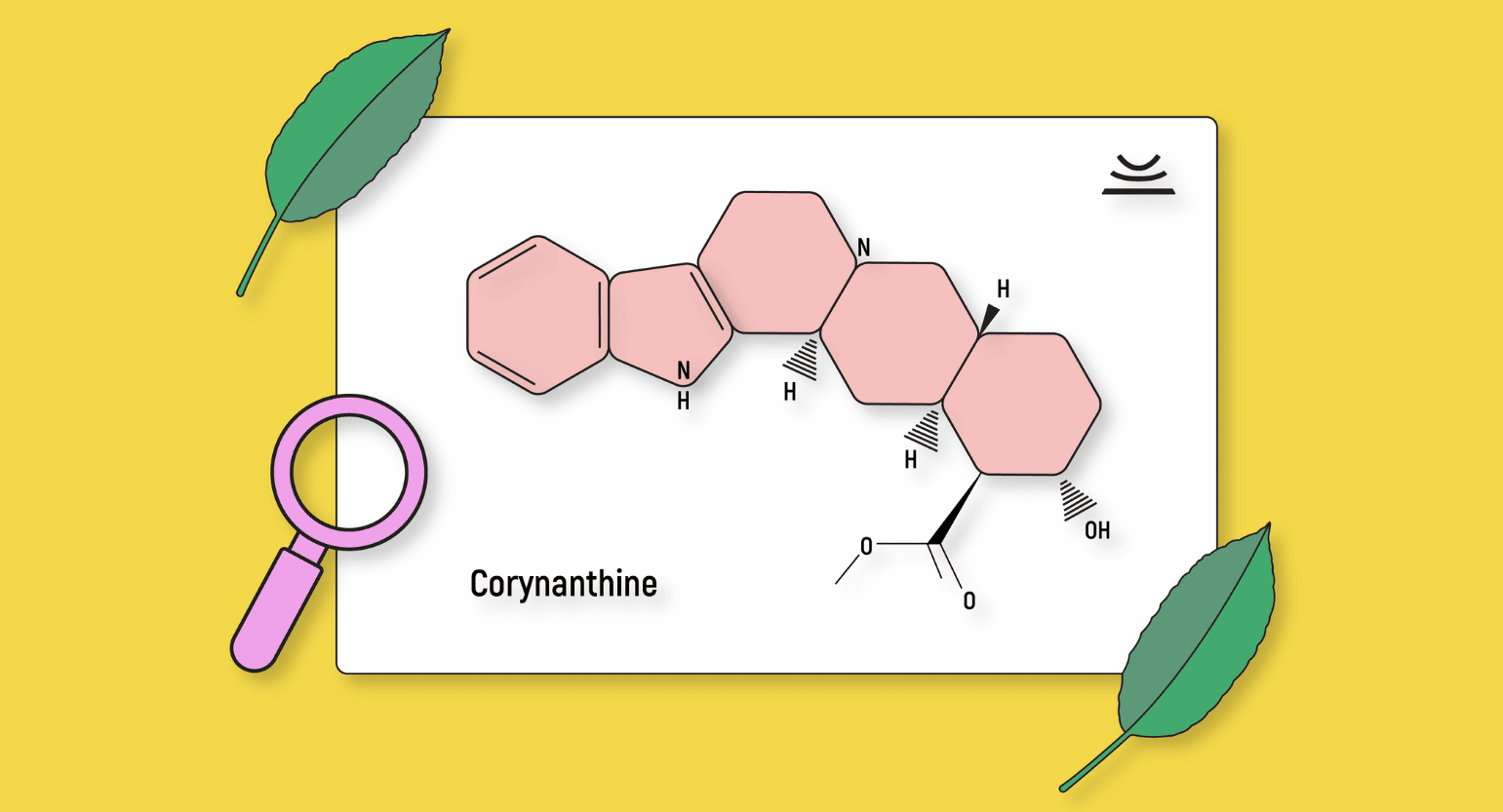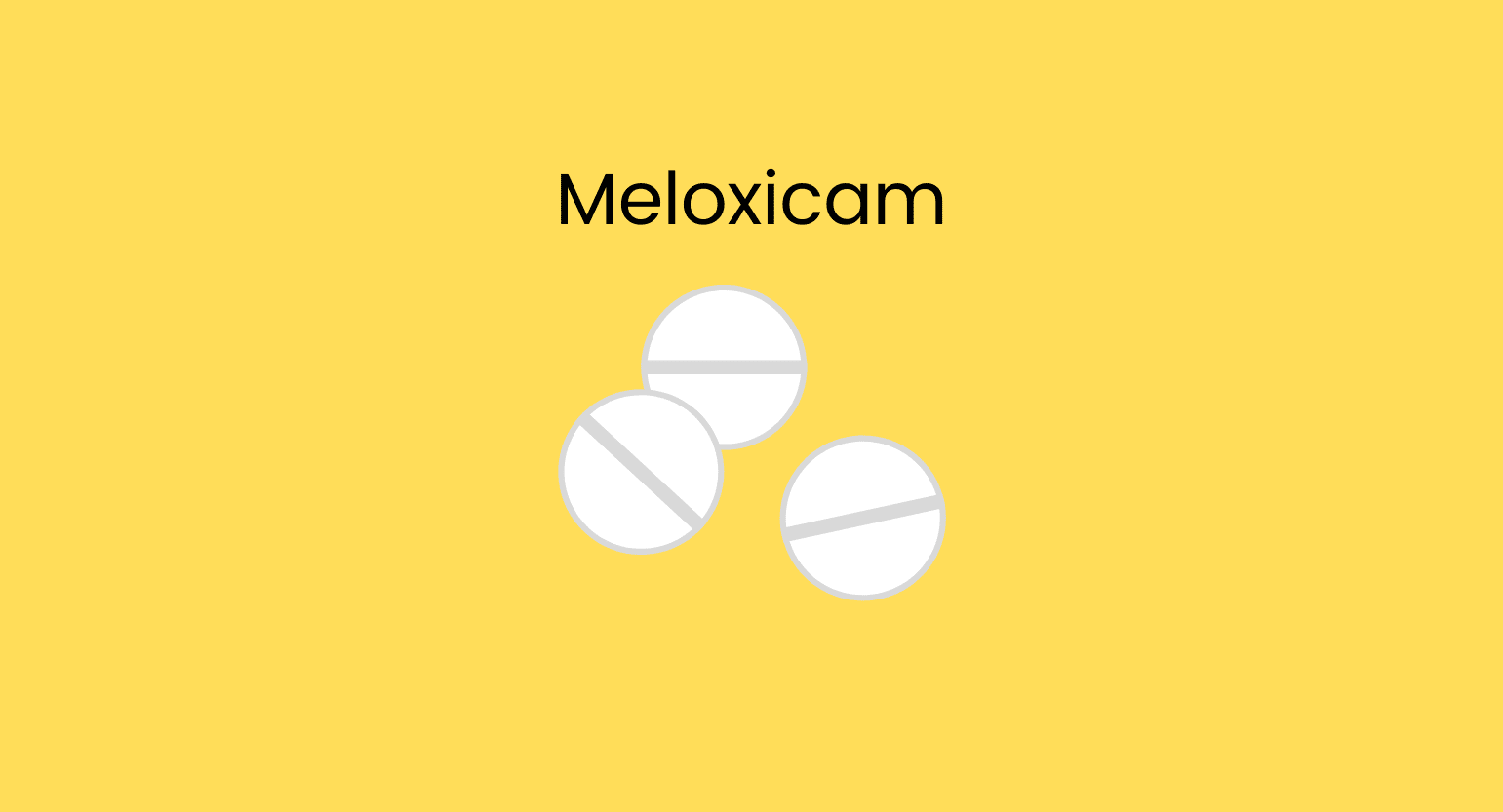Description of Boswellia
Boswellia serrata is the most common of several frankincense plants associated with frankincense. It’s a large tree that prefers to branch out on dry mountains throughout India, parts of northern Africa, and the Middle East.
However, four other trees are also considered frankincense trees. The resin harvested from each tree varies significantly in its aroma and constituents, although most tend to share similar herbal actions and properties.
- Boswellia carterii, or B.sacra, also known as olibanum or, more commonly, dragon’s blood, is most likely the frankincense tree mentioned in the Bible.
- Boswellia frereana and Boswellia thurifera both grow naturally in northern Somalia. These trees are the ones from which Coptic and Maydi frankincense are derived and subsequently revered by Islamic peoples in Saudi Arabia and the Coptic church. These trees have a more citrus-like scent than the other frankincense trees; most people know of them due to their use in the mass production of chewing gum.
- Boswellia papyrifera grows mainly in Ethiopia and Sudan. It produces a resin-like oil, transparent rather than a thick and solid resin.
Frankincense is most often used as incense or as an aromatherapy aid. The incense is often devotional — that is, burned as an offering to a deity — whereas the essential oil can be applied in a diffuser for personal use.
The essential oil of frankincense comes from the raw resin, a thick sap-like material not unlike that which you would find oozing from a Northern Cedar. Many are surprised to learn that this resin can actually provide numerous health benefits when consumed.
By weight, the frankincense resin contains up to 10% essential oils, a fairly large amount compared to most other plants. This primarily contributes to the incredibly potent aroma that most people are familiar with. The remainder consists of mostly polysaccharides and other phytochemicals.
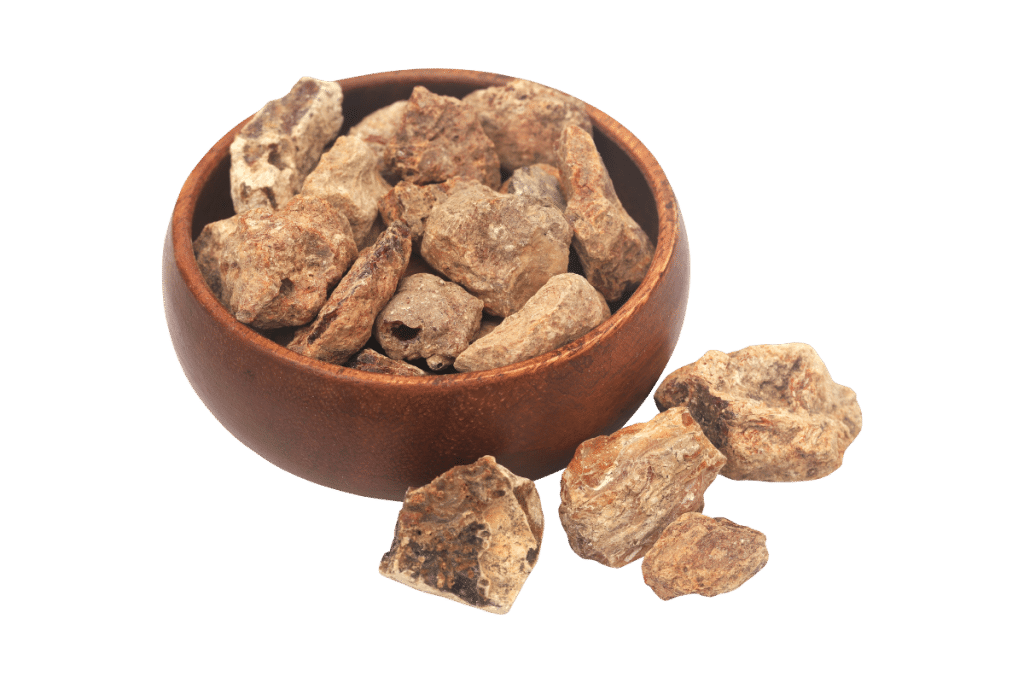
The resin has other medicinal purposes and can be employed as a sort of dull, spicy chewing gum with antimicrobial benefits that are great for your teeth.
Pro tip: the same is true of most tree saps. Simply break off a small piece of dried sap, pop it into your mouth, and roll it about a bit until the moisture and heat melt it into a sort of paste that protects your teeth. Generally, you’ll want to avoid swallowing saps and resins, though — frankincense included.
Cultivating & Processing
Once the tree reaches maturity, the resin is harvested once annually for only three years. Following this, there is a significant degradation in the resin’s quality.
Before harvest throughout the summer and autumn months, the tree must first be wounded ahead of time in spring. A sharp cut is inflicted, and the bark peels back slightly, allowing the sap to ‘bleed’ out.
Over time, the sap hardens into a ‘frankincense tear’ and can be chewed straight off the tree. It is much more potent and flavorful when chewed fresh, although most of the world will never get the opportunity to do so since much of the resin’s potency is lost by the time it is exported.
If the tree is left alone for several years, it may rejuvenate to the point that it can produce quality resin once again. The color and consistency can change, but the resin of B. serrata generally remains golden brown, sometimes green-tinged, depending on where and when it was harvested.
Obviously, different trees in the genus will have different resins. The resin of B. carterii is generally much darker, and the tree itself prefers to grow in the lush green oasis of the Dhofar valley in Oman. The limited space this tree likes to grow in has led to relative scarcity.
The resin of B. papyrifera, which prefers to grow in Ethiopia and Sudan, creates a resin almost entirely lacking in color. The transparent resin is much oilier than the other species.
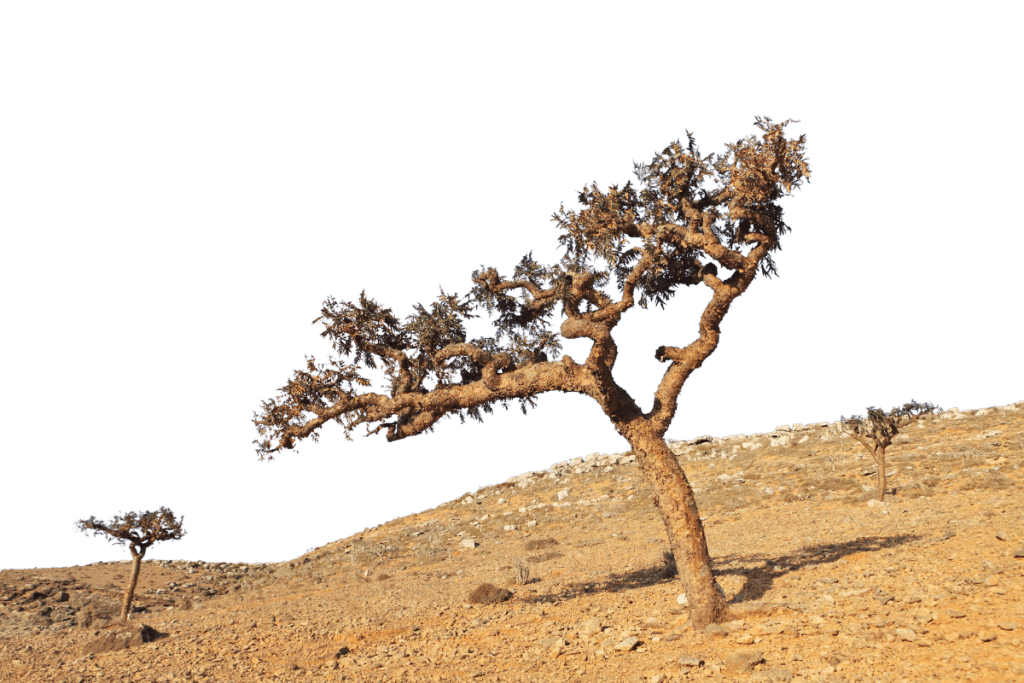
The geography, season, size, and health of the tree, the size of the puncture wound from where the resin was extracted, and the processing and storage methods used will impact the resin’s color.
Oxidation, polymerization, and reactive enzymes can all lead to further darkening of the frankincense resins.
Traditional & Conventional Uses
Frankincense is one of the most prized ingredients in the traditional medicine system of India, known as Ayurvedic medicine.
Best translated as the Science of Life, Ayurveda is a holistic and largely preventative medical system that ascribes great value to many plants and herbs that Western medicine considers useless. Conventional Western medicine, on the other hand, is barely beginning to recognize the potency of Boswellia.
Ayurvedic Use of Boswellia
Two massive volumes of text are still frequently referenced and stand as the pillars of Ayurvedic medicine: the Charaka Samhita (India’s first medical text considered valid and effective), and the Sushruta Samhita, an attempt to compile all available information available in 600 BC.
Both of these works cite the importance of frankincense multiple times.
One of the main benefits of frankincense is its ability to fight arthritis and rheumatism. Interestingly enough, these two benefits are the main reasons that Westerners are currently studying frankincense since it shows remarkable potential.
Gugguls, which roughly translates into the tree’s gum resin, was later described in other writings as a treatment for the following:
- Cardiovascular problems
- Dysentery
- Fever
- Hair loss
- Jaundice
- Menstrual issues
- Pulmonary issues such as bronchitis and asthma
- Ringworms and other parasites
Frankincense is a potent sattvic herb that purifies the mind and nerves, helping to bring both the mind and spirit into a state of clarity and serenity. Its pungency helps to burn away impurities in the nadis (subtle nerve channels).
Frankincense’s spiritual benefits are immense. It is often combined with herbs like calamus and Gotu kola, which have an affinity for the mind and spirit. It works well as an aid in meditation, both externally (when inhaled) and when chewed.
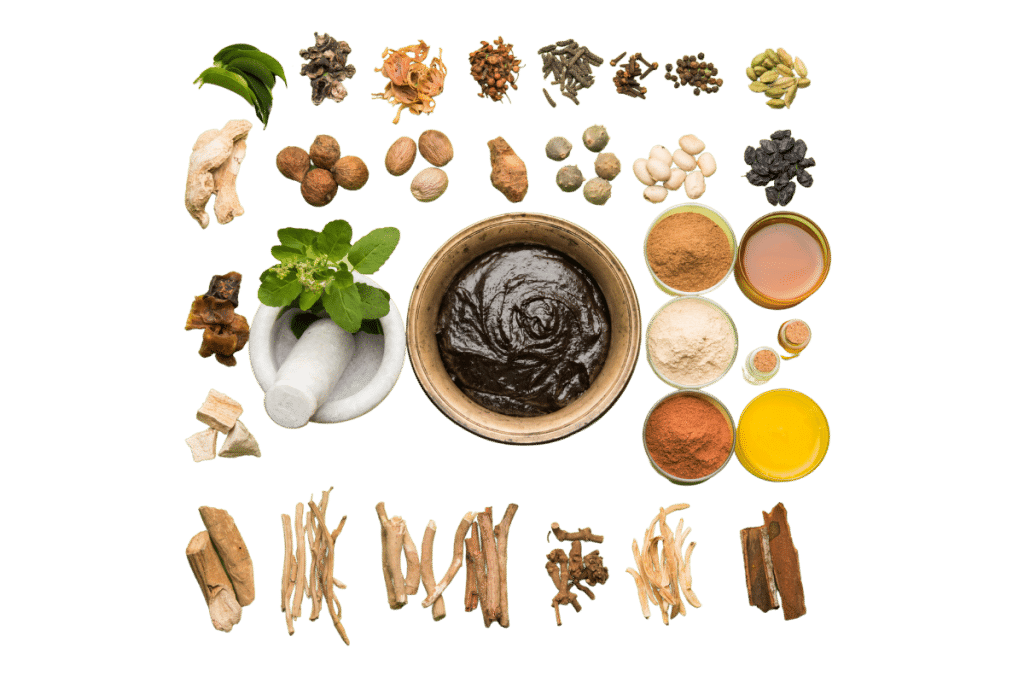
It can pacify the Vata dosha due to its ability to calm and replenish the nervous system by reducing anxiety and restlessness. It energizes and revitalizes, thus clearing excess Kapha from the body and reducing chronic fatigue and depressive states [26].
Traditional Chinese Medicine (TCM) & Boswellia
Known in TCM as Ru Xiang, or the Fragrant Milk, Boswellia has been used for centuries to help promote the circulation of blood and Qi (the subtle energy force which gives rise to life and is the primary object of TCM’s focus). Frankincense further helps to improve the regeneration of tissues and to reduce swelling.
Its first mention in Chinese literature was around 600 AD when it was referenced in the Mingyi Bielu. This document’s title translates as “supplementary records of famous physicians” and was compiled by the Taoist pharmacologist Tao Hongjing who lived from 456-536 AD.
According to TCM, frankincense has warm, bitter, and pungent properties, with an affinity for the spleen, heart, and liver.
Its primary use is dispersing Wind-Damp from the meridians and relaxing the sinews.
As a warming herb, frankincense helps to correct excess yin (cold) energy. As a bitter, frankincense tends to dry out dampness; its pungency helps promote qi and fluid circulation.
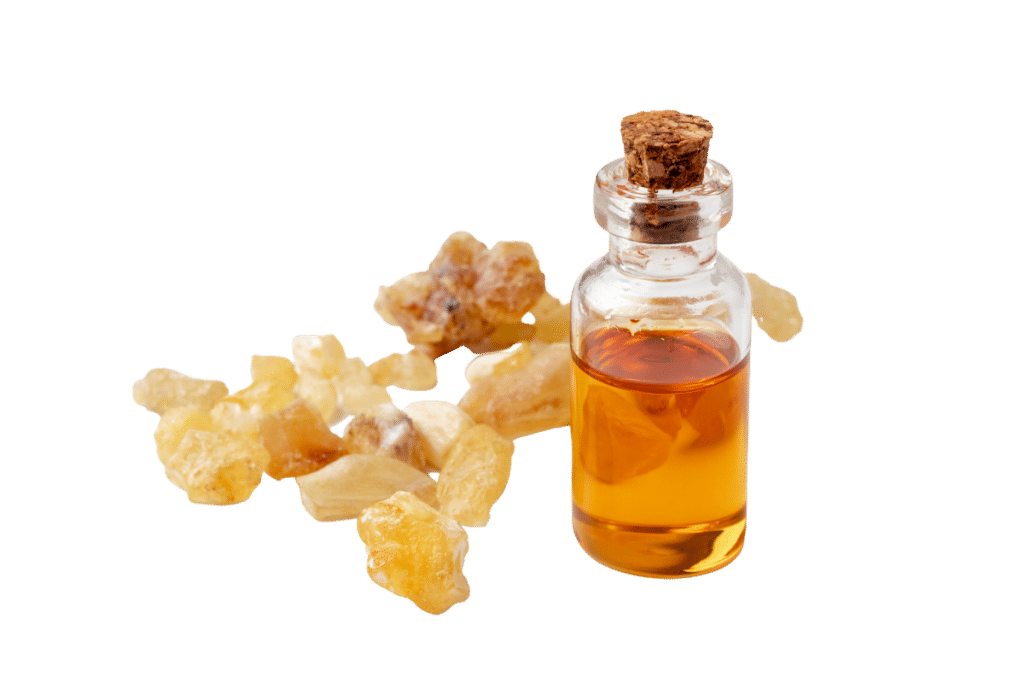
It’s important to note that TCM is a highly comprehensive and in-depth science that never recommends self-prescribing. Almost anything used in TCM is prescribed alongside something else to help maximize its effects and serve as a counterbalance to prevent any potential imbalance.
The conjunctive herbs prescribed will depend on the individual’s constitution and thus must be determined by a trained practitioner. Identifying the best additional herbs requires an analysis of your basic state of being and the harmony between the various elements of your body compared to those of the herbs.
Herbal & Pharmaceutical Actions
Frankincense has several important pharmaceutical and herbal actions.
Western herbalism ascribes the following actions to it:
- Analgesic
- Anti-inflammatory
- Antibacterial
- Anticancer
- Antidepressant
- Antioxidant
- Antiseptic
- Antiviral
- Aromatic
- Astringent
- Digestive
- Purification
- Stimulant
Western herbal medicinal indications include:
- Cancer
- Fighting bronchitis
- Headaches
- Improving digestion
- Infections
- Pain
- Reducing anxiety and depression
- Swelling
- Ulcerations
Traditional Chinese medicine ascribes the following actions:
- Generating flesh
- Invigorating Blood
- Moving Qi
- Preventing stagnation
- Reducing swelling
- Relaxing sinews
Eastern medicinal indications include relieving the following:
- Amenorrhea
- Asthma
- Cancer
- Dysmenorrhea
- Headaches
- Masses
- Pain
- Postpartum abdominal pain
- Respiratory conditions
- Rigidity
- Spasms
- Stagnation
- Swelling
Frankincense History & Folklore
Frankincense has one of the most interesting histories of any medicinal component. At one time, it was considered more valuable than gold, and many people labored and toiled in the hot Arabian desert to extract the resin for sale on the Silk Road.
Its first recorded reference comes from the Egyptian Ebers Papyrus, which was written in 1500 BC.
Judaism
In Judaism, frankincense was in religious ceremonies as a key component of the “four sweet scents,” the others being stacte, onycha, and galbanum. So potent was this perfume that anybody who used it for personal enjoyment was cut off from their people.
The Bible reports that the baby Jesus was given frankincense along with myrrh, according to the Gospel of Matthew.
“And when they were come into the house, they saw the young child with Mary his mother, and fell down, and worshiped him: and when they had opened their treasures, they presented unto him gifts; gold, and frankincense, and myrrh. (Matthew 2:11, KJV)”
Frankincense is considered the king of oils and was a primary ingredient of holy incense and used as medicine and currency.
People often overlook the significance of the Messiah, Jesus Christ, often referred to as the Anointed One. The biblical importance of anointing with fragrant oils is incredible. The scent of Jesus Christ was said to be fragrant enough to be detected in the spiritual realm. It was said to be the fragrance of life.
The incense made from frankincense and myrrh was placed on the Inner Altar of the Tabernacle and burned morning and evening, acting as an intercession between people and the Lord. Combined with myrrh, it represents the Messiah’s role as both Priest and Prophet.
It was said to be so sacred that God himself decreed against its personal use, decrying it only as a sacrificial offering to him.
“Gather fragrant spices — resin droplets, mollusk shell, and galbanum — and mix these fragrant spices with pure frankincense, weighed out in equal amounts. Using the usual techniques of the incense maker, blend the spices and sprinkle them with salt to produce pure and holy incense. Grind some of the mixture into a very fine powder and put it in front of the Ark of the Covenant, where I will meet with you in the Tabernacle. You must treat this incense as the most holy. Never use this formula to make this incense for yourselves. It is reserved for the Lord, and you must treat it as holy. Anyone who makes incense like this for personal use will be cut off from the community.” (Exodus 30:34–38, NLT).”
Though the Bible reports that this recipe came from God, it may be that the Israelites learned how to prepare this incense during their time enslaved in Egypt. This occurred before the Exodus, and the Egyptians were known to use frankincense widely. It has been found on mummies and is believed to have been one of their embalming agents.
Ancient Cultures
The Babylonia, Persians, Assyrians, Romans, and Indians considered frankincense a sacred and ceremonial scent used as incense.
In Arabia, where most frankincense originates, the trees are said to be guarded by winged serpents. This was first reported by the Greek writer Herodotus and was part of a myth developed to ward off rival harvesters.
The Chinese associate it with death. Its name in Chinese can be translated as “calling back the soul fragrance,” and it was used during ceremonies that mourned the dead.
The resin is also mentioned in the Periplus of the Erythrean Sea, a sailor’s guide to the various shipping routes in the Mediterranean, Arabian Gulf, and the Indian Ocean. The book says that the resin harvested from the Southern Arabian regions was better inequality than that found in East Africa.

Its popularity surged with the development of the international trade routes established during antiquity. It was a staple on both the Silk Road and the Incense Trade Route. The latter traveled through Arabia, East Africa, and India. The Silk Road traveled from Parthia through to Asia [25].
The massive desire for frankincense led to the Nabataean culture‘s development in the first century BC. The culture established a monopoly on frankincense trading by gaining control over the Incense Trade Route rather than control of the plants themselves.
How is Frankincense Used?
Different cultures and medicinal systems would employ frankincense in different ways.
The resin was, and still is occasionally, consumed orally. However, most people and practitioners agree that the gastrointestinal discomfort resulting from oral use generally outweighs the potential health benefits.
Thus, frankincense is often used via inhalation or topical application. Pharmaceutical usage involves extracts or isolated versions of specific compounds. However, many studies do involve the consumption of frankincense gum.
In all cultures, the resin and the essential oil of frankincense are employed for their medicinal components. Modern medicine has begun to isolate specific constituents and evaluate them for their specific biological effects to develop the most powerful agents for fighting particular symptoms.
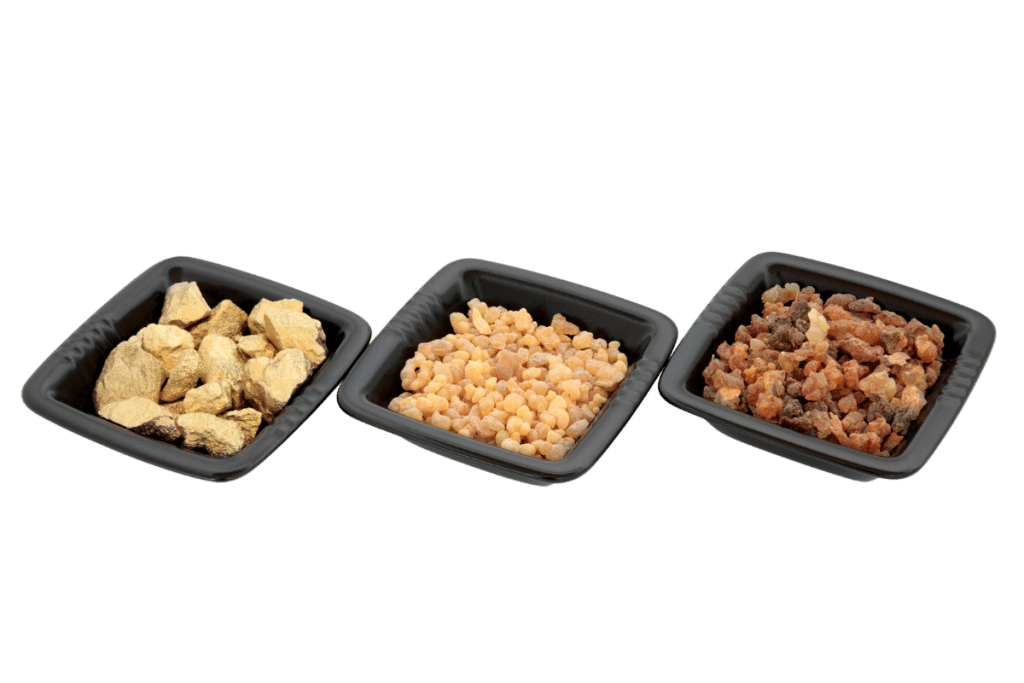
Ayurvedic Usage
In Ayurveda, frankincense is employed in many different ways [24].
- Frankincense’s main use is for the treatment of arthritis and rheumatism. It’s combined with other anti-inflammatory agents like ginger and turmeric to help maximize its benefits.
- Frankincense helps stimulate the spirit and the mind. It contains sesquiterpenes, carbon-based aromatic compounds that can directly stimulate the limbic system, the pineal gland, and the pituitary.
- For managing respiratory problems, frankincense oil would often be diffused into the atmosphere using an oil nebulizer and then inhaled. Alternatively, the strong essential oil could be diluted in a carrier oil and massaged into the chest.
- For managing skin conditions, diluted oil can be applied directly. Frankincense oil is one of the few that tends not to irritate the skin, although dilution is still recommended, especially during larger applications.
- For its digestive benefits, fresh frankincense resin would be chewed whenever available. The dried resin works well as a substitute. Pressing the gum into cavities can reduce dental pain and slow the growth; diluted essential oil can be gargled and swished to improve oral health.
TCM Usage
Frankincense is considered one of the chief herbs in TCM’s traumatology department. Traumatic injuries tend to lead to the stagnation of blood and qi; frankincense helps to reinvigorate these systems to prevent stagnation.
Frankincense is almost always combined with Mo Yao, or myrrh, due to the two herbs’ ability to potentiate one another. Both are bitter, pungent, and warm, indicated for the rejuvenation of stagnant blood and qi and for treating traumatic injuries [23].
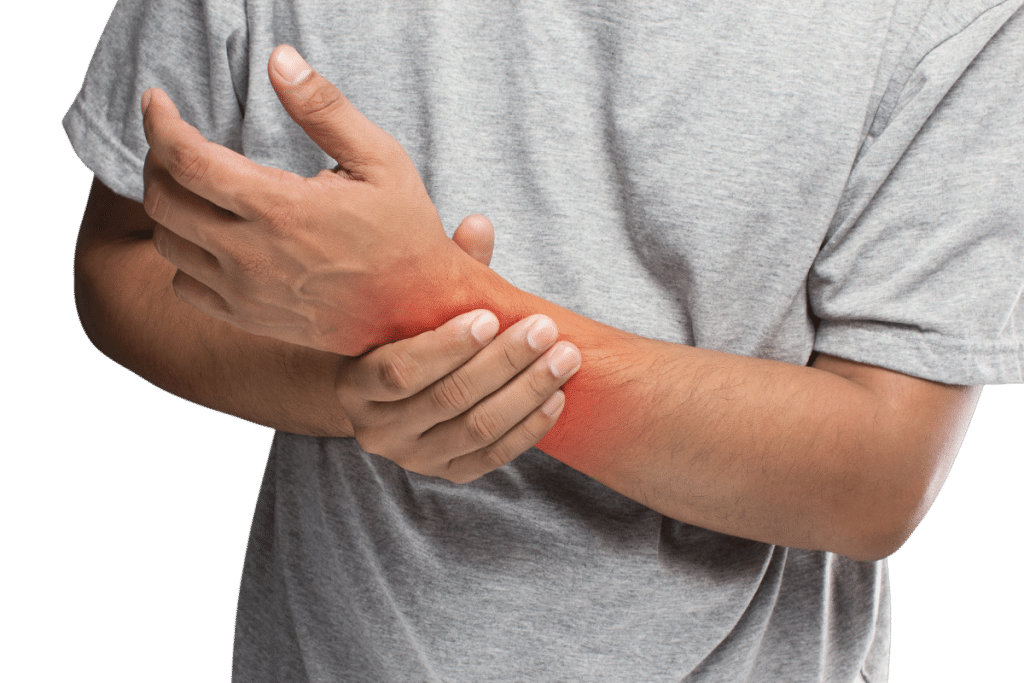
For swelling and pain, it’s often combined with Xue Jie (dragon’s blood) and Hong Hua (Safflower) in addition to Mo Yao. The high potency of these herbs’ bitter, warming, and stimulating activity can help to dredge stagnation.
Preparations in TCM often involve stir-baking the frankincense resin until the oil can be removed before internal usage. If the resin cannot be stir-baked, or if it’s powdered, it can be used externally.
Active Constituents & Alkaloids in Boswellia
There are a great deal of different active constituents in Boswellia.
Frankincense essential oil is the most common form of medicine in the West. The oil contains a dense concentration of terpenes, hence its potent aroma [1]:
- A-pinene, between 2-64%
- B-pinene, between 0.3-13.1%
- A-thujene, between 0.3-52.4%
- Myrcene, between 1.1-22.4%
- Sabinene, between 0.5-7%
- Limonene, between 1.3-20.4%
- P-cymene, between 2.7-16.9%
- B-caryophyllene, between 0.1-10.5%
- Atenolol, trace
- Incensole acetate, trace
- Incensole, trace
- Bornyl acetate, trace
- Linalool, trace
- Octyl acetate, trace
However, despite the frequency and import of essential oil, it’s not the most important medicinal component of frankincense. The various Boswellia spp. include several acid resins and other compounds, most importantly Boswellia acids.
3-acetyl-beta-boswellic acid, alpha-boswellic acid, 4-O-methyl glucuronic acid, and incensole acetate are all important medicinal compounds that contribute to the health benefits of frankincense.
Scientific Evidence for Benefits of Frankincense
Many studies have confirmed some of the numerous benefits of frankincense. Here are quoted some of the most significant and promising.
Fights Inflammation
The anti-inflammatory action of the various Boswellia species results from several different mechanisms. The majority of the work is done by a certain class of terpenoids known as Boswellia acids.
These acids from the gum resin frankincense can directly prevent the body from producing inflammatory lipoxygenase products. The potency of the inhibition increases along with the dose [3].
Impressively, Boswellia acts on several of the same biological pathways as typical over-the-counter anti-inflammatory drugs.
However, these drugs carry the risk of inducing reasonably significant side effects. Ironically, these side effects often exacerbate the conditions the drugs are supposed to help with; examples include the rapid acceleration of degenerative damage caused by arthritic conditions or ulcerations of the digestive tract [4].
Glycosaminoglycan inhibition, caused by these pharmaceutical agents, is generally what causes these problems. Boswellia, on the other hand, actually increases the synthesis of this enzyme and enhances protection against these problems [5].
These properties also encourage Boswellia to protect the body against cancer, microbes, and other threats to the immune system.
The various methods by which Boswellia reduces inflammation allow for it to produce many different benefits.
- In patients with psoriasis, applying frankincense to the affected areas can reduce scales by as much as 70% [6].
- Whole frankincense or an extract of Boswellia acids helps reduce inflammatory pain in the joints caused by arthritis.
- Frankincense can help to reduce inflammation following a brain injury and thereby reduce the chances of permanent damage [7].
Enhances Skin Health
Frankincense helps reduce the instance of fibroblasts in human skin tissue. One study evaluated a common frankincense essential oil product and its influence on human skin cells [2].
The essential oil was proven to influence a number of pathways and genetic conditions that result in inflammation. Frankincense oil helps to modulate inflammation and improve tissue remodeling, thus increasing the speed of wound repair.
The study evaluated a genome-wide analysis that looked at 21,224 genes. Frankincense was proven to be significantly active and strongly affected the genetic biomarkers associated with inflammation.

Improves Dental Health
Frankincense has long been touted as a herbal agent for improving dental health. Even before it was studied for this effect, its ability to freshen breath was obvious to even the most skeptical observers.
More recently, a study evaluated the effects of chewing frankincense gum on the microbial content of the mouth. Subjects chewed the gum over five hours [21].
Antimicrobial Activity
Various extracts and isolated compounds of Boswellia have proven to be helpful in inhibiting the growth of various microbial agents.
A sweeping and non-specific evaluation of the oil showed that it could help fight bacteria and fungi and boost immunity and improve the body’s ability to eliminate pathogens [17].
One study compared the effect of frankincense oil individually against fungi and gram-positive and gram-negative bacterial strains.

Respiratory Benefits
Boswellia also helps to prevent the body from producing human leukocyte elastase. Researchers believe this may be involved in forming, or susceptibility to, emphysema [8].
This same elastase leads to increased mucus production in the bronchial airways, a known contributing factor for diseases like cystic fibrosis, chronic bronchitis, and emphysema.
Another important study evaluated the effects of consuming frankincense resin among patients with asthma. The study, which is in the European Journal of Medical Research, revealed that a dose of only 300 mg of frankincense three times a day led to an “obvious improvement” in the symptoms of asthma in 70% of patients [16].
Fights Cancer
Boswellia can help reduce the proliferation of cancer cells and seems to be able to differentiate between healthy and cancerous cells.
Leukotrienes are compounds that produce chemotaxis and chemokinesis and contain within their genetic information the directions for the production of superoxide radicals and phagocyte activity, all of which can contribute to cancer development.
By slowing the production of leukotrienes, Boswellia helps to prevent the disease from developing.
Boswellic acids bind to the enzyme 5-lipoxygenase, allowing its direct inhibition in neutrophilic granulocytes. These pentacyclic triterpenoid acids further induce cell apoptosis and can prevent topoisomerases of leukoma and glioma cell lines [9].
Frankincense can also help prevent the spread and development of melanoma cancer and reduce the side effects of chemotherapy treatments that fight it. The most common side effects of chemotherapy are hepatotoxicity and cytotoxicity, both of which frankincense can help reduce [22].

Boosts Immunity
Various compounds present in frankincense have been shown to interact positively with the immune system. These compounds are active both when used in their isolated form and when contained within gum resin extracts [18].
The two most potent compounds in regard to immunomodulation are 11-keto-beta-boswellic acid (KBA) and acetyl-1-keto-beta-boswellic acid. It’s unclear how much influence other phytochemicals present in the resin have on human immunity. Many seem to exert some degree of beneficial action.
High doses of Boswellia acids, for example, slow the production of antibody titers. That said, smaller amounts improved antibody titers after sheep received erythrocytes. Likewise, low doses seem to increase lymphocyte production, whereas high doses inhibit them.
Enhances Memory
The same study which proved Boswellia effective as an antimicrobial agent also revealed its ability to improve cognition and memory. One of the reasons for this is that the plants’ antimicrobial agents work via the inhibition of an enzyme called acetylcholinesterase.
This enzyme breaks down a neurotransmitter called acetylcholine. This compound transmits memory and other input information from cell to cell. It keeps our brains working effectively and allows us to recall and commit new memories.
Of all the extracts tested, the ethyl acetate soluble fraction of frankincense resin, derived from methanol extract, was the most effective. Boswellic acids were later individually extracted and evaluated.
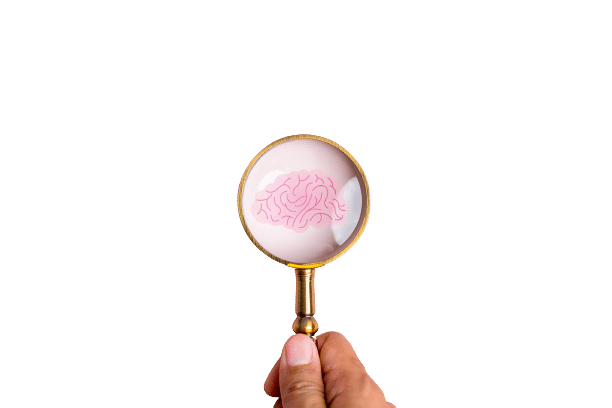
The most potent acetylcholinesterase inhibitor was 11a-hydroxy-b-boswellic acid; the second strongest was 11-keto-b-boswellic acid [19, 20].
Digestive Benefits
Boswellia can be useful for treating numerous inflammatory digestive conditions, including ulcerative and chronic colitis, Crohn’s Disease, IBD, and ileitis.
One study evaluated Boswellia’s effect on patients struggling with ulcerative colitis. The typical drug used to treat this condition is sulfasalazine. Boswellia proved significantly more effective, causing 14 out of the 20 patients to go into remission as opposed to 4 of the 10 who were taking the prescription drugs [11].
On top of that, all patients except for one in the Boswellia group noted improvements in at least one, if not more, measurement of quality of life.
Another study evaluated the effect of one of Boswellia’s active constituents, acetyl-11-keto-b-boswellic acid, on inflammatory bowel disease. The impact of the individual constituent was compared against a complete Boswellia extract.
The extract and the isolated compound significantly improved the health of the animals who were forcibly induced with IBD [12].
Another study evaluated the effects of Boswellia serrata extracts compared to mesalazine, the pharmaceutical most often used to treat symptoms of Crohn’s Disease, in patients who suffered from the condition.
The Boswellia extract proved to be as effective as the pharmaceutical extract in reducing symptoms and improving the overall quality of life [13].

Leukocytic invasion contributes to the development of superficial ulcers in patients with colitis. By reducing leukocyte production, Boswellia reduces the frequency and intensity of superficial ulcers, hallmarks of the condition.
In particular, it shows promise in reducing the production of leukotrienes and their infiltration in patients with ulcerative colitis [9].
Arthritis Benefits
Frankincense helps patients who suffer from knee osteoarthritis. Patients received either a gram of frankincense resin or a placebo during one study. The placebo group did not notice a significant improvement in their range of motion or decreased pain. However, all subjects in the frankincense group noted improvements [14].
Despite historical usage as a treatment for rheumatism, one of the studies evaluating frankincense’s ability to improve rheumatic pain was unsatisfactory.
While the frankincense extract did not lead to any significant improvements compared to the placebo, it did lead to a decrease in the overall consumption of non-steroidal anti-inflammatory drugs in the Boswellia group [15].
Further research led to conflicting, and much more positive results. This research resulted from the observation that leukotrienes perpetuate a number of chronic inflammatory conditions.
Safety & Precautions
There is currently no recommended dose for frankincense. Studies that report improved health conditions involve amounts varying from 600-3000 mg of gum resin or an equivalent [10].
One must also be cautious when purchasing products made with Boswellia. Because there is no medical standardization, one cannot be sure whether or not they are buying a reliable product. Indeed, science does not confirm what constitutes a reliable frankincense product.
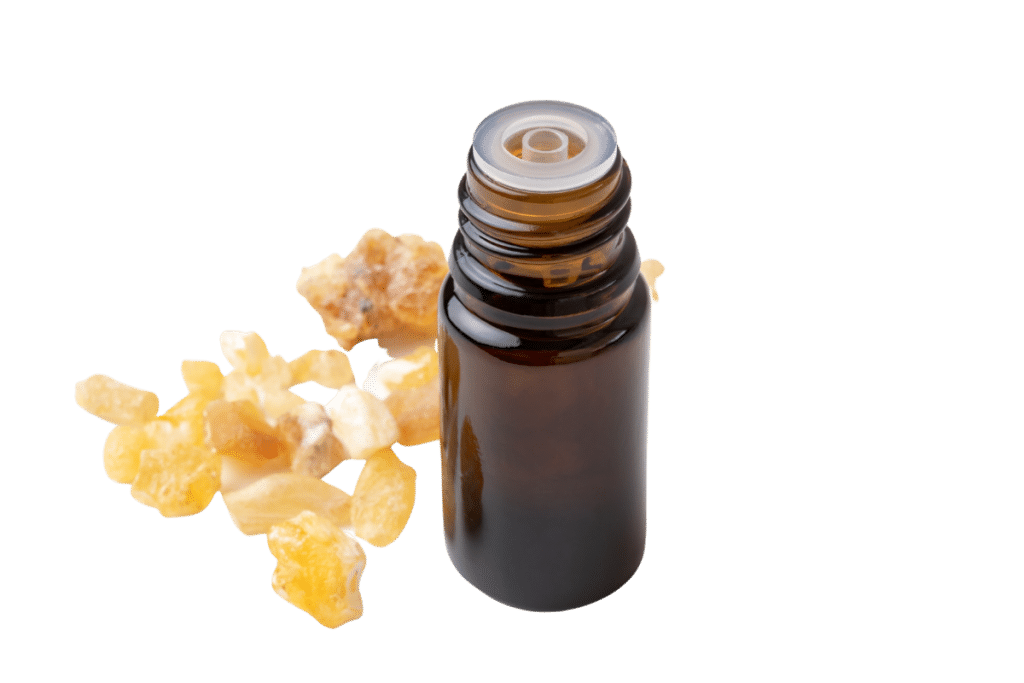
While some mild side effects can occur due to oral ingestion, no long-term or severe effects have been reported in all of the studies on frankincense [10].
Conclusion: Frankincense Uses
Frankincense is one of the most historically important plants in the world. Its influence as both a medicinal and spiritual agent has influenced cultures across the globe, maintaining a position important in many of the world’s largest religions.
Even today, frankincense remains a popular agent in many traditional medicine systems. Science is beginning to prove the value of frankincense and its extracts in treating numerous health conditions, and more research is underway.
Whether you’re burning frankincense incense during your meditation or chewing on the gum to aid your digestion and improve your oral hygiene, rest assured that it will do you no harm. No studies have revealed any toxic results from the over-ingestion of Boswellia, although you may want to avoid consuming it on an empty stomach to avoid discomfort.
- Van Vuuren, S. F., Kamatou, G. P., & Viljoen, A. M. (2010). Volatile composition and antimicrobial activity of twenty commercial frankincense essential oil samples. South African Journal of Botany, 76(4), 686-691.
- Han, X., Rodriguez, D., & Parker, T. L. (2017). Biological activities of frankincense essential oil in human dermal fibroblasts. Biochimie open, 4, 31-35.
- Ammon, H. P. T., Mack, T., Singh, G. B., & Safayhi, H. (1991). Inhibition of leukotriene B4 formation in rat peritoneal neutrophils by an ethanolic extract of the gum resin exudate of Boswellia serrata. Planta medica, 57(03), 203-207.
- Siddiqui, M. Z. (2011). Boswellia serrata, a potential anti-inflammatory agent: an overview. Indian journal of pharmaceutical sciences, 73(3), 255.
- Al-Yasiry, A. R. M., & Kiczorowska, B. (2016). Frankincense-therapeutic properties. Advances in Hygiene & Experimental Medicine/Postepy Higieny i Medycyny Doswiadczalnej, 70.
- Fadaei, F., Ayati, M. H., Firooz, A., Younespour, S., Abouali, M., & Tabarrai, M. (2022). Efficacy of a topical herbal cream containing frankincense oil, pumpkin oil, and licorice aqueous extract in patients with mild-to-moderate plaque psoriasis: a randomized clinical trial. Research Journal of Pharmacognosy, 9(1), 89-101.
- Hosny, E. N., Elhadidy, M. E., Sawie, H. G., Kilany, A., & Khadrawy, Y. A. (2020). Effect of frankincense oil on the neurochemical changes induced in rat model of status epilepticus. Clinical Phytoscience, 6(1), 1-11.
- Safayhi, H., Rall, B., Sailer, E. R., & Ammon, H. P. T. (1997). Inhibition by boswellic acids of human leukocyte elastase. Journal of Pharmacology and Experimental Therapeutics, 281(1), 460-463.
- Ammon, H. P. (2002). Boswellic acids (components of frankincense) as the active principle in treatment of chronic inflammatory diseases. Wiener medizinische Wochenschrift (1946), 152(15-16), 373-378.
- Ernst, E. (2008). Frankincense: systematic review. Bmj, 337.
- Gupta, I., Parihar, A., Malhotra, P., Singh, G. B., Lüdtke, R., Safayhi, H., & Ammon, H. P. (1997). Effects of Boswellia serrata gum resin in patients with ulcerative colitis. European journal of medical research, 2(1), 37-43.
- Krieglstein, C. F., Anthoni, C., Rijcken, E. J., Laukötter, M., Spiegel, H. U., Boden, S. E., … & Schürmann, G. (2001). Acetyl-11-keto-β-boswellic acid, a constituent of a herbal medicine from Boswellia serrata resin, attenuates experimental ileitis. International journal of colorectal disease, 16(2), 88-95.
- Gerhardt, H., Seifert, F., Buvari, P., Vogelsang, H., & Repges, R. (2001). Therapy of active Crohn disease with Boswellia serrata extract H 15. Zeitschrift fur Gastroenterologie, 39(1), 11-17.
- Mohsenzadeh, A., Karimifar, M., Soltani, R., & Hajhashemi, V. (2022). Evaluation of the effectiveness of topical oily lotion containing frankincense extract in the treatment of knee osteoarthritis: a randomized, double-blind, placebo controlled clinical trial.
- Sander, O., Herborn, G., & Rau, R. (1998). Is H15 (resin extract of Boswellia serrata,” incense”) a useful supplement to established drug therapy of chronic polyarthritis? Results of a double-blind pilot study. Zeitschrift fur Rheumatologie, 57(1), 11-16.
- Gupta, I., Gupta, V., Parihar, A., Gupta, S., Lüdtke, R., Safayhi, H., & Ammon, H. P. (1998). Effects of Boswellia serrata gum resin in patients with bronchial asthma: results of a double-blind, placebo-controlled, 6-week clinical study. European journal of medical research, 3(11), 511-514.
- Ota, M., and Houghton, P., 2005. Boswellic acid with acetylcholinesterase inhibitory properties from frankincense” 53rd annual
- congress organized by society of medicinal plants. Societa Italiana di Fitochimica Florence, PP: 330
- Ammon HP. Modulation of the immune system by Boswellia serrata extracts and boswellic acids. Phytomedicine. 2010 Sep;17(11):862-7. doi: 10.1016/j.phymed.2010.03.003. Epub 2010 Aug 8. Erratum in: Phytomedicine. 2011 Feb 15;18(4):334. PMID: 20696559.
- Evans, D. A., Funkenstein, H. H., Albert, M. S., Scherr, P. A., Cook, N. R., Chown, M. J., … & Taylor, J. O. (1989). Prevalence of Alzheimer’s disease in a community population of older persons: higher than previously reported. Jama, 262(18), 2551-2556.
- Houghton, PJ , Ren, Y , Howes, MR . (2006) Acetylcholinesterase inhibitors from plants and fungi. Natural Product Reports, 23, 181–199.
- Sabra, S. M., & Al-Masoudi, L. M. (2014). The effect of using frankincense (Boswellia sacra) chewing gum on the microbial contents of buccal/oral cavity, taif, KSA. J Dent Med Sci, 13(4), 77-82.
- Hakkim, F. L., Bakshi, H. A., Khan, S., Nasef, M., Farzand, R., Sam, S., … & Tambuwala, M. M. (2019). Frankincense essential oil suppresses melanoma cancer through down regulation of Bcl-2/Bax cascade signaling and ameliorates heptotoxicity via phase I and II drug metabolizing enzymes. Oncotarget, 10(37), 3472.
- Cao, X., Bai, Z., Sun, C., Yang, Y., & Sun, W. (2021). Mechanism of “Ruxiang-Moyao” herbal pair in the treatment of knee osteoarthritis based on network pharmacology. Chinese Journal of Tissue Engineering Research, 25(5), 746.
- Dohling, C. (2008). Boswellia serrata (Frankincense)-from traditional Indian medicine (Ayurveda) to evidence-based medicine. Phytomedicine: International Journal of Phytotherapy & Phytopharmacology, 15(6-7), 540-541.
- Ben-Yehoshua, S., Borowitz, C., & Ondrej Hanuš, L. (2012). 1 frankincense, myrrh, and balm of Gilead: Ancient spices of Southern Arabia and Judea. Horticultural Reviews, 39(1), 3-66.
- Dzouza, Z. (2013). EFFECT OF SHALLAKI ON KNEE OSTEOARTHRITIS (JANU SANDHIGATA VATA). Journal of Ayurveda and Holistic Medicine (JAHM), 1(3).
- Monga, A. B., & John, D. R. (2007). Cultural differences in brand extension evaluation: The influence of analytic versus holistic thinking. Journal of consumer research, 33(4), 529-536.
- Wierzbicki, A. P. (2016). Systemic synthesis and metaphysics: Eastern versus Western thinking. In Knowledge Synthesis (pp. 1-14). Springer, Tokyo.


